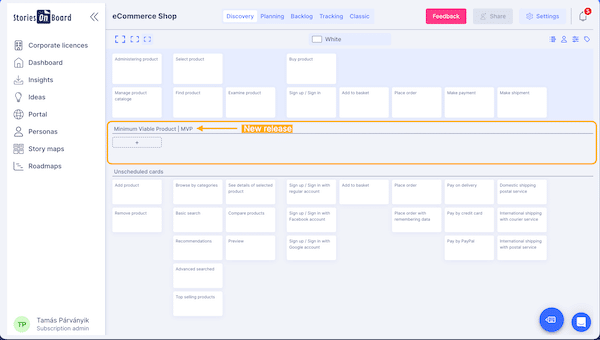In this article, we will explore the benefits of release planning. Release planning is a key step in agile software development that ensures the delivery of the product vision, project success, and efficiency.
Release management is the process of planning and scheduling software releases, including testing and deployment processes. It involves preparing iterative, incremental project schedules, outlining product goals and objectives, and defining a timetable for completion. By taking the time to plan, teams can avoid common pitfalls and anticipate potential challenges.
Contents
What is Agile release planning?
Release planning is about defining the desired outcome of one or more major releases and maximizing the chances of achieving it. This involves: setting clear, specific, and measurable goals that describe the outcomes or benefits that the product should deliver.
In Agile release planning the Product Owner and the product team plan incremental releases of a product instead of linear, long-term projects. It means you make releases in phases and then break them down into several sprints or iterations that can run simultaneously. Agile release planning differs from traditional, Waterfall software planning methods where you focus on one major release at a time.
Release planning involves creating a document about which product versions will be released and when. Sharing the agile release plan of milestones already achieved and those to come until product release keeps stakeholders informed and helps agile teams stay on track.
Agile development methodology breaks down the development process into releases, rather than trying to release all the features developed in one huge and complex project, typically over a quarter. Agile release planning also creates flexibility for projects and openness to change.
A successful two to three-week sprint ends with the completion of a new product increment, but this does not necessarily mean a product release. An agile approach to software development supports more frequent releases of smaller increments, as continuous delivery means more frequent value creation for customers, less stress for the development team, less preparation for DevOps, and less risk if something goes wrong.
Plan Releases as Experiments with Progressive Delivery
Treat each release as a testable hypothesis, not just a shipment. Pair release planning with experiment design to validate value early and cut waste. Techniques like progressive delivery and feature flags let you roll out to small cohorts, compare outcomes, and roll back safely.
Bake measurement into the plan. Before the sprint, define outcome metrics (activation, task completion, retention), guardrails (error rate, latency), cohorts, and a rollout timeline. Set success and stop-loss thresholds up front, and put the analysis and decision checkpoint on the calendar alongside the release date.
- Frame a clear hypothesis: “If we ship X for Y users, then Z will improve by N%, measured by M.”
- Select cohorts and a rollout strategy (beta users, canary rings, region, or percentage-based exposure).
- Instrument events and dashboards before development; plan any A/B or holdback you’ll need.
- Set success criteria and guardrails to trigger automated rollback or pause.
- Time-box analysis: review results within days of release, then decide to ramp, iterate, or retire.
- Capture learnings and attach them to the backlog items so they inform the next release slice.
Release plan and product roadmap – what is the difference?
The roadmap provides a high-level view of the strategic implementation of the product vision, while the release plan provides a detailed description of the project tasks and their deadlines.
The release plan is more detailed: it outlines the specific features, functionality, tasks, deadlines, and improvements that will be delivered in a given release.
Product roadmaps generally provide an overview of the direction of product development over a 6-12 month period, while release plans typically provide more detailed information on specific features and enhancements to be implemented in the short term.
What is a release planning session?
Product release planning is a bit like sprint planning: they are also essential to develop common goals and shared knowledge within the development team. The release planning meeting is an important collaboration and a critical opportunity to get buy-in from the dev team and DevOps. A well-managed release planning session is led by the Product Owner or the Product Manager and empowers participants to further communicate and confirm relevant details with the rest of the delivery team.
Release planning starts with having the right representative in the room and inviting key staff from different departments with complementary skills. For maximum effectiveness, aim to have at least 4 and no more than 7 or 8 people plus the PO.
Start it by discussing (or revisiting) why product release matters
Ask questions like:
- By when do we anticipate seeing these results?
- How will we measure success?
Take care to assess team alignment at this stage.
Discuss how the product or feature should work
Now we can start to discuss features and functionality:
- What is the task the user wants to accomplish?
- Which user(s) wants to accomplish this task?
- Why do they want to accomplish this task?
- How often will they want to complete this task?
- How valuable will this feature be?
In agile software development, the goal of each sprint is to release an “increment of a potentially deliverable product”.
Splitting the story map into several releases helps to decide which features should be delivered in which order, hence the name ” release planning “. You can think of slicing up a story map as simply drawing a horizontal line under the details of all the features that should be included in the first release called MVP (Minimum Viable Product.
Release planning and release management with StoriesOnBoard
Now let’s see how StoriesOnboard can help you with release management. StoriesOnBoard is a lightweight product management tool built around user story mapping. You can use story maps as visual product backlogs that everybody quickly understands.
Here’s how you can slice out and manage releases in user story maps:
MVP
In developing a new product, the very first release includes the user stories that form the backbone of the product being developed: only the minimum usable and marketable features are included. You can create your first release and future releases by selecting the user stories that are essential to the product’s value proposition.
Here is our step-by-step article on how to define your MVP by mapping user stories:
Release view and release management
The release view is a simplified list view of a release on the story map. It can be useful for easier tracking of the status of a project. It provides a simplified list of stories based on their status. Release view can be shared via a link with project participants and external partners, decision-makers, and even the customer, to show the team or stakeholders the relevant part of the story map.

StoriesOnBoard allows you to provide details about your releases. You can enter different information for the release details and set the start and end date of the release. In the release summary, you can also find status reports by card or estimated time and effort of the implementation.
The status report shows the number and status of stories in the release and also shows a pie chart of them, where you can choose to list story cards by status or estimate. It is also possible to find cards that do not yet have an estimate.
It is also possible to synchronize release dates, release statuses, and dates with JIRA and GitHub.
You can also manage your releases: name, rename, archive, or delete them.
Learn more about release management in StoriesOnBoard
Release roadmap
Parallel releases and the simultaneous use of multiple story maps for a large project also require transparency due to the complexity. There is of course a solution to this in StoriesOnBoard.
The release roadmap and the portfolio roadmap summarize the releases of multiple story maps. These work great if you are using the releases to group user story maps to get a high-level overview of the project.
Learn more about release roadmaps and portfolio roadmap features in StoriesOnBoard
Summary
- Release planning is a key step in agile software development that helps ensure communication between team members, project success, and effectiveness. Release planning also provides a clear prioritization of planned product features and the prioritization of different product versions over time.
- Agile release planning involves planning incremental releases of a product instead of linear, long-term projects, creating flexibility and openness to change.
- A successful release planning session involves having the right representatives in the room, discussing project goals and measures of success, and aligning the team on features and functionality.
Release planning FAQ for product managers and product owners
What is Agile release planning?
It sets clear outcomes for one or more releases and gives you the best chance of hitting them. Teams plan incremental releases, split work into sprints, and share milestones so stakeholders stay informed and the team stays aligned.
How is a release plan different from a product roadmap?
A roadmap sketches the strategic direction for the next 6-12 months. A release plan zooms in on the near term: specific features, tasks, and deadlines for the upcoming release.
Who should attend a release planning session?
A Product Owner or Product Manager leads with key cross-functional reps, including dev and DevOps. Keep it tight: 4-8 participants plus the PO to maintain focus, alignment, and buy-in.
How do we choose what goes into the first release (MVP)?
Include only the minimum usable and marketable features that deliver the product's core value. Use a story map to slice priorities and pick the essential user stories for the MVP.
How does user story mapping help release planning?
It turns the backlog into a visual map everyone understands, making it easy to slice into releases. It keeps discussions anchored on user tasks, frequency, and value so the team stays aligned.
How frequently should we release?
Most teams run two- to three-week sprints that produce potentially shippable increments. You don't have to release every sprint, but Agile favors smaller, more frequent releases to deliver value continuously.
How do we track and share release progress with stakeholders?
Use StoriesOnBoard's Release View to track status by story and share a link externally. Status reports summarize counts and estimates, with charts and filters, including one for unestimated items.
Can we manage parallel releases across multiple teams?
Yes. StoriesOnBoard's Release Roadmap and Portfolio Roadmap aggregate releases from multiple story maps to provide a transparent, high-level view for complex initiatives.
How does Agile release planning reduce risk and improve efficiency?
Smaller, frequent releases lower deployment stress, cut DevOps prep overhead, and limit the blast radius if issues occur. They also preserve flexibility and make change easier to absorb.
Does StoriesOnBoard integrate with our delivery tools?
StoriesOnBoard can synchronize release dates and statuses with JIRA and GitHub. You can also manage releases (name, rename, archive, or delete) as plans evolve.
